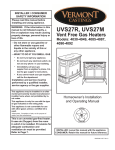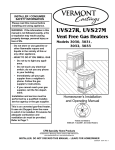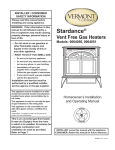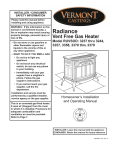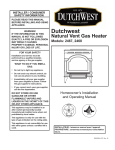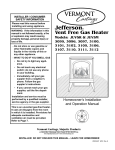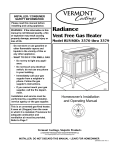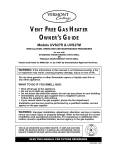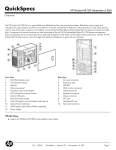Download DutchWest 2476 Operating instructions
Transcript
INSTALLER / CONSUMER SAFETY INFORMATION Please read this manual before installing and using appliance. WARNING: If the information in this manual is not followed exactly, a fire or explosion may result causing property damage, personal injury or loss of life. —Do not store or use gasoline or other flammable vapors and liquids in the vicinity of this or any other appliance. —WHAT TO DO IF YOU SMELL GAS • Do not try to light any appliance. • Do not touch any electrical switch; do not use any phone in your building. • Immediately call your gas suppler from a neighbor’s phone. Follow the gas suppler’s instructions. • If you cannot reach your gas supplier, call the fire department. Installation and service must be performed by a qualified installer, service agency or the gas supplier. This is an unvented gas-fired heater. It uses air (Oxygen) from the room in which it is installed. Provisions for adequate combustion and ventilation air must be provided. Refer to Page 7. Dutchwest Vent Free Gas Heater Models: 2475, 2476 Homeowner’s Installation and Operating Manual 2008 Dutchwest I GN gasDESstove cover 6/03 CE RTIFI E D INSTALLER: Leave this manual with the appliance. CONSUMER: Retain this manual for future reference. 30002068 3/08 Rev. 8 Dutchwest Vent-Free Gas Heater Table of Contents PLEASE READ THE INSTALLATION & OPERATING INSTRUCTIONS BEFORE USING APPLIANCE. Thank you and congratulations on your purchase of a Dutchwest stove. IMPORTANT: Read all instructions and warnings carefully before starting installation. Failure to follow these instructions may result in a possible fire hazard and will void the warranty. Installation and Operating Instructions General Information............................................................................................................. 3 Gas Heater Dimensions ...................................................................................................... 4 Clearance Requirements..................................................................................................... 5 Hearth Requirements .......................................................................................................... 5 Gas Specifications............................................................................................................... 6 Gas Inlet and Manifold Pressures ....................................................................................... 6 High Elevations ................................................................................................................... 6 Odor During Operation ........................................................................................................ 6 Vent Free Features.............................................................................................................. 7 Fresh Air Requirements....................................................................................................... 7 Assembly Procedures Install Optional Fan Kit ........................................................................................................ 9 Install ON/OFF Switch ....................................................................................................... 10 Thermostat Connections ................................................................................................... 11 Connect the Gas Supply LIne ........................................................................................... 11 Install Log Set.................................................................................................................... 11 Install Stove Front ............................................................................................................. 13 Operation Your First Fire .................................................................................................................... 14 Pilot and Burner Inspection ............................................................................................... 14 Flame & Temperature Adjustment ..................................................................................... 14 Flame Characteristics........................................................................................................ 14 Lighting Instructions .......................................................................................................... 15 Troubleshooting ................................................................................................................. 16 Maintenance Firebox Cleaning and Inspection ....................................................................................... 18 Cleaning Procedure........................................................................................................... 18 Care of Cast Iron ............................................................................................................... 18 Replacement Parts ...................................................................................................................... 19 Optional Accessories Fan Kits 21 Glass / Catalyst Kit ............................................................................................................ 21 Remote Controls ............................................................................................................... 21 Warranty ....................................................................................................................................... 22 2 30002068 Dutchwest Vent-Free Gas Heater Installation & Operating Instructions In order to ensure safe and effective installation, this unit must be installed only by a qualified agency, individual, firm, corporation or company that is experienced in the installation, repair and servicing of this type of appliance and is familiar with the building codes and installation techniques appropriate in your area. Contact your hearth products dealer or local gas supplier for the name of a qualified service person. IMPORTANT: Read this owner’s manual carefully and completely before trying to assemble, operate, or service this heater. Improper use of this heater can cause serious injury or death from burns, fire, explosion, electrical shock, and carbon monoxide poisoning. Failure to follow instructions may result in property damage, bodily injury or loss of life. This manual contains important user information. Keep this manual with the heater after installation is complete. FOR SAFE INSTALLATION AND OPERATION, PLEASE NOTE THE FOLLOWING: 1. Use only Natural Gas with Model 2475. Use only Propane with Model 2476. Do not use any other fuels. 2. Install only in accordance with the National Fuel Gas Code, ANSIZ223.1/NFPA54-latest edition. (Exception: Do not derate this appliance for altitude. This appliance has been tested and listed for use in altitudes up to 10,000 feet.) 3. Use only the installation instructions provided by the manufacturer for this appliance. Installation and repair should be done by a qualified installer, preferably NFI or WETT (Canada) certified. The appliance should be inspected before use and at least annually by a professional service person. More frequent cleaning may be required due to excessive lint from carpeting, bedding material, etc. It is imperative that control compartments, burners and circulating air passageways of the appliance be kept clean. 4. WARNING: Any change to this heater or its controls can be dangerous. DO NOT make modifications to any heater or associated parts. 5. DO NOT install this heater in a bedroom or bathroom. 6. Due to high surface temperatures, DO NOT install this heater • in a recreational vehicle, • where curtains, furniture, clothing or other flammable objects are less than 36 inches from the front, top or sides of the heater, • in high traffic areas, • in windy or drafty areas. 7. DO NOT place clothing or other flammable material on or near the appliance. 8. DO NOT obstruct the top grille at all. Doing so will cause high levels of carbon monoxide that will lead to death. 30002068 CARBON MONOXIDE POISONING MAY LEAD TO DEATH! Carbon Monoxide Poisoning: Early signs of carbon monoxide poisoning resemble the flu, with headaches, dizziness, or nausea. If you have these signs, the heater may not be working properly. Get fresh air at once! Have the heater serviced. Some people are more affected by carbon monoxide than others. These include pregnant women, people with heart or lung disease or anemia, those under the influence of alcohol, and those at high altitudes. 9. This heater needs fresh, outside air ventilation to operate properly. See Fresh Air Requirements on Pages 7. 10. If heater shuts off, heater may not have enough fresh air ventilation. Provide more fresh air. If heater keeps shutting off, refer to Troubleshooting. 11. DO NOT operate this heater • where flammable liquids or vapors are used or stored • under dusty conditions. 12. The heater becomes very hot when operating. Alert children and adults to stay away from hot surfaces to avoid burns or clothing ignition. The heater will remain hot for a time after shutdown. Allow surface to cool before touching. 13. Carefully supervise young children when they are in the room with the heater. 14. Do not use the heater if any part has been exposed to or under water. Immediately call a qualified service technician to inspect the room heater and to replace any part of the control system and any gas control which has been under water. 15. DO NOT operate the heater if any log is broken or damaged. 16. Turn heater off and let cool before servicing. Only a qualified service person should service and repair heater. 17. DO NOT operate this appliance with the safety screen removed. If the safety screen is removed from the appliance for service or cleaning, it must be replaced before operating the heater. NOTE: If any of the original wire as supplied with the appliance must be replaced, it must be replaced with a wire of at least 105°F temperature rating. Proposition 65 Warning: Fuels used in gas, woodburning or oil fired appliances, and the products of combustion of such fuels, contain chemicals known to the State of California to cause cancer, birth defects and other reproductive harm. California Health & Safety Code Sec. 25249.6 3 Dutchwest Vent-Free Gas Heater Dutchwest Vent Free Gas Heater Dimensions Drawing Not to Scale 6���" (172mm) CL Valve Inlet 24���" (622mm) 28���" (721mm) C Valve 4���" L Inlet (111mm) 12���" (318mm) 23" (584mm) 17" (419mm) 2068 Fig. 1 Dutchwest dimensions. 2008 Dutchwest NV dimensions 6/23/03 4 30002068 Dutchwest Vent-Free Gas Heater Clearance Requirements A Minimum Clearances to Combustible Materials B Maintain clearance, (empty space), between combustible materials and the heater as specified below for the appropriate firebox shell being installed. C A E T D B D S U C V F W G X Y H Z ST101 A: B: C: D: Mantel/Trim* .......................... 35” (889mm) / 2” (51 mm) Side Wall/Trim*............................................. 2” (51 mm) ST101 Rear Wall ....................................................... 0” (0 mm) Clrnc 13” (330 mm) Max. Mantel WidthMin. ................................... Alcove Clearances B 4/15/99 djt D B A ST599a Ref. A B C D E F G H Mantel Shelf Depth Ref. 13” (330 mm) S 11¹⁄₄” (286 mm) T 9³⁄₈” (241 mm) U 7¹⁄₂” (191 mm) V 5³⁄₄” (146 mm) W FP599a 4” (102 mm) X stove mantel heights 2¹⁄₄” (579/27/99 mm)djt Y 1” (25 mm) Z Mantel from Stove Top 35” (889 mm) 30” (762 mm) 25” (635 mm) 20” (508 mm) 15” (381 mm) 10” (254 mm) 5” (127 mm) 2” (51 mm) Hearth Requirements ST103 A: B: C: D: C Ceiling ...................................................... 35” (889 mm) ST103 Side Wall ...................................................... 2” (51 mm) Min. Clrnc 0” (0 mm) Rear Wall ....................................................... 4/15/99 djt Max. Alcove Depth ................................... 13” (330 mm) The Stove must be installed on rigid flooring. If the appliance is installed on any combustible surface other than wood flooring, such as carpet or tile, a metal or wood panel must be installed to extend the full length and width of the unit. WARNING • Do not install this heater in a bathroom or bedroom. • Installation of this heater must conform with local codes or, in the absence of local codes, with the National Fuel Gas Code, ANSI Z223.1 / NFPA54. • This heater creates warm air currents. These currents move heat to wall surfaces next to the heater. Installing the heater next to vinyl or cloth wall coverings or operating the heater where impurities in the air such as tobacco smoke exist, may discolor walls. • Do not use a blower insert, heat exchanger insert or other accessory not approved for use with this heater. 30002068 5 Dutchwest Vent-Free Gas Heater High Elevations Gas Specifications Model 2475 2476 Fuel Nat Prop Gas Control Millivolt Millivolt Firebox weight / shipping Max. Input BTU/h 28,000 28,000 Min. Input BTU/h 19,500 19,500 110 lbs. Gas Inlet and Manifold Pressures Natural Inlet Minimum Inlet Maximum Manifold Pressure 5.5” w.c. 14” w.c. 3.5” w.c. LP (Propane) 11” w.c. 14” w.c. 10” w.c. (MP) 11” w.c. (RP) Dutchwest Vent-Free Certified to: ANSI Z21.11.2b-2004 Unvented Heaters The installation of your Dutchwest stove must conform with local codes, or in the absence of local codes, with the National Fuel Gas Code ANSI Z223.1/NFPA 54 - latest edition. (EXCEPTION: Do not derate this appliance for altitude up to 4,500 feet (1,370m). Maintain the manifold pressure at 3.5” w.c. for Natural Gas and 11.0” w.c. for LP Gas. This appliance may be installed in an aftermarket* manufactured (mobile) home, where not prohibited by state or local codes. This appliance is to be used only with the type of gas specified on the rating plate which is attached to the rear panel. This appliance is not convertible for use with other gases. Input ratings are shown in BTU per hour and are certified without deration from elevations up to 4,500 feet (1,370m) above sea level. Nuisance outages may occur at altitudes above 4,500 feet (1,370m) if dirt, dust, lint and/or cobwebs are allowed to accumulate on burner and/ or ODS pilot. Monthly inspection and cleaning is recommended for altitudes above 4,500 feet (1,370m) For elevations above 4,500 feet (1,370m), installations must be in accordance with the current ANSI Z223.1/NFPA 54 and/or local codes having jurisdiction. WARNING: Improper installation, adjustment, alteration, service or maintenance can cause injury or property damage. Refer to this manual for correct installation and operational procedures. For assistance or additional information consult a qualified installer, service agency, or the gas supplier. Odor During Operation Neither natural gas nor propane gas give off an odor when burned. The nature of a vent free combustion system, however, is such that odors may occasionally be produced during heater operation when impurities exist in the immediate area. Cleaning solutions, paint, solvents, cigarette smoke, candles, adhesives, new carpet or textiles, etc., all can create fumes. These fumes may mix with combustion air and can create odor. Such odors will disappear over time, however the condition can be alleviated by opening a window or otherwise providing additional ventilation to the area. *Aftermarket: Completion of sale, not for purpose of resale, from the manufacturer. 6 30002068 Dutchwest Vent-Free Gas Heater Vent Free Features The Dutchwest Vent Free, Model Nos. 2475 and 2476, are unvented gas heating appliances tested and listed to the ANSI Standard Z21.11.2a-2001. This appliance is specifically configured to burn either Natural Gas or Propane fuel, as indicated on the metal rating plate attached to the rear shroud. These stoves are not fuel convertible. The stove is shipped fully assembled and ready for installation. The firebox assembly is composed of the NG or LP Burner, a base plate, firebox and screen. The log set, burner tube, gas valve and pilot comprise the Burner assembly. The Dutchwest Vent Free stove is equipped with a Honeywell control valve that allows thermostatic control, on/off switch or a remote switch (not supplied). Both models incorporate variable regulators that allow you to adjust burner heat output between HIGH, (28,000 BTU), and LOW, (19,500 BTU). See the Operation Section for details. The standing pilot incorporates an Oxygen Depletion System (ODS/pilot) designed to shut off the appliance if enough fresh air is not available. Fresh Air Requirements for Combustion and Ventilation WARNING This heater must have fresh air for proper operation. If not, poor fuel combustion could result. Read the following instructions to insure proper fresh air for this and other fuel-burning appliances in your home. Modern construction standards have resulted in homes that are highly energy-efficient and that allow little heat loss. Your home needs to breathe, however, and all fuel-burning appliances within it require fresh air in order to function properly and safely. Exhaust fans, clothes dryers, fireplaces, and other fuel burning appliances all use the air inside the building. If the available fresh air is insufficient to meet the demands of these appliances, problems can result. The Dutchwest vent free heater has specific fresh air requirements. You must determine that these fresh air requirements will be met within the space where the appliance will be installed. The following information will help you insure that adequate fresh air is available for the heater to function properly. 30002068 Provide For Adequate Ventilation Any space within a home can be classified in the following categories: 1) Unusually Tight Construction 2) Confined Space 3) Unconfined Space First, determine which classification defines the intended space. Unusually Tight Construction You must provide additional fresh air if the space falls into this classification. Unusually Tight Construction is defined as construction wherein: a. walls and ceilings exposed to the outside atmosphere have a continuous water vapor retarder with a rating of one perm or less with openings gasketed or sealed and b. weather stripping has been added on openable windows and doors and c. caulking or sealants are applied to areas such as joints around window and door frames, between sole plates and floors, between wall-ceiling joints, between wall panels, at penetrations for plumbing, electrical, and gas lines, and at other openings. If your home meets all of the three criteria above, you must provide supplemental fresh air for the appliance from outside the home as detailed on page 7, B. If your home does not meet the above criteria, follow the procedure below. Determine if You Have a Confined or Unconfined Space Use the following formula to determine if you have a confined or unconfined space. Space is defined as the room in which you will install the heater plus any adjoining rooms with doorless passageways or ventilation grilles between the rooms. The National Fuel Gas Code defines a confined space as a space whose volume is less than 50 cubic feet per 1,000 BTU per hour, (4.8 m3 per kw), of the aggregate input rating of all appliances installed in that space and an unconfined space as a space whose volume is not less than 50 cubic feet per 1,000 BTU per hour, (4.8 m3 per kw), of the aggregate input rating of all appliances installed in that space. Rooms communicating directly with the space in which the appliances are installed, through openings not furnished with doors, are considered a part of the unconfined space. 1. Determine the volume of space, (length x width x height). Include adjoining rooms connected by doorless passageways or ventilating grilles. 7 Dutchwest Vent-Free Gas Heater Example: A room that is 18’ x 12’ x 8’ has a volume of 1728 cubic feet, ( length x width x height). An adjoining open kitchen that is 10’ x 12’ x 8’ has a volume of 960 cubic feet. An adjoining open dining room is 12’ x 12’ x 8’ with a volume of 1152 cubic feet. The total space volume is 3840 cubic feet. (1728 + 960 + 1152). 2. Divide the volume of space by 50 cubic feet. The result is the maximum BTU/Hr that the space can support. Example: 3840 divided by 50 = 76.8 or 76,800 BTU/Hr. 3. Add the BTU/Hr ratings of all fuel-burning appliances installed in the same space, including the following: Gas Water Heater Gas Furnace Gas Fireplace Logs Unvented Gas Heater Vented Gas Heater* Other Gas Appliances* * Do not include Direct Vent appliances as these utilize outside air for combustion and vent to the outdoors. Example: Gas Range 55,000 BTU/Hr Unvented Heater +33,000 BTU/Hr Total 88,000 BTU/Hr 4. Compare the maximum BTU/Hr rating the space can support with the total BTU/Hr used by the appliances. Example: 76,800 BTU/Hr - max. the space can support 88,000 BTU/Hr - total used by appliances In this example, the maximum BTU/Hr that the space can support is less than the total used by the appliances, the space is considered to be Confined space. Additional air must be provided to meet the requirements of the Unvented heater. A confined space may be ventilated in two ways: A) Open up or provide at least two ventilating grilles to an adjoining unconfined space. Use any of the options illustrated in Figure 2. Each of the two grilles must provide an opening of at least 50 square inches, with all opening dimensions being at least 3”. One grille must be located within 12” of the ceiling; the other within 12” of the floor. (If the total exceeds 100,000 BTU/Hr, additional grilles will be required.) B) Vent the room directly to the outdoors. (Provide one square inch of opening for each 4,000 BTU/hr. If the total BTU/Hr used by the appliances is less than the maximum BTU/Hr the space is able to support, the room meets the Unconfined space criteria and no further ventilation is required. For further information on ventilation guidelines and sizing specifications follow the National Fuel Gas Code NFPA 54/ANSI Z223.1 Section 5.3. WARNING This heater shall not be installed in a confined space or unusually tight construction unless provisions are made for adequate combustion and ventilation air. WARNING If the area in which the heater may be operated is smaller than that defined as an unconfined spaceof if the building is of unusually tight constructins, provide adequate combustion and ventilation air by one of the methods described in the National Fuel Gas Code, ANSI Z223.1/ NFPA 54, Section 5.3 or applicable codes. 12” Option 1 Vents to Adjoining Room Option 3 Vents to Adjoining Room Option 2 - Remove Door to Adjoining Rooms 12” VO370-2 Fig. 2 Vent options to provide additional air. 8 vent370-2 Ventilation options 3/26/99 djt 30002068 Dutchwest Vent-Free Gas Heater Assembly Procedures Install the Optional Fan 1. The fan kit includes a blower assembly and a rheostat assembly, connected by a cable. The blower assembly mounts to the bottom rear of the stove, and the rheostat mounts to the left side of the valve. The assembly includes a ‘snapstat’ which automatically turns the fan ON (or OFF) above (or below) approximately 109°F. The rheostat also provides a range of fan speed settings from Off (which overrides the snapstat function) to High. Unpack and inspect the blower assembly. Confirm that the fan spins freely. 2. Attach the fan assembly to the bracket provided in the log box. Use #10 sheet metal screws provided with fan kit. Do not remove finger guard screws. (Fig. 3) Snapstat Wire 4. To install the fan assembly, it is necessary to remove the firebox from the stove. Remove the stove front and screen. Slide the firebox out of the unit and carefully lay it on its back on a protected surface. 5. Remove fan shield plate attached to the inner shroud. (Fig. 5) Retain screws for later use. NOTE: The fan shield is attached upside down for shipping purposes only. Inner Shroud Rheostat Wire Fan Shield Plate Fan Bracket ST781 Fig. 5 Remove fan shield plate and retain screws. 6. Place the grommet provided in the manual bag assembly on the inner shroud. Run the snapstat extension assembly leads between the inner and outer shroud and through theST781 grommet with the flag female terminals toward the front of the stove. (Fig. 5) Finger Guard ST669 remove fan shield plate 9/03 djt Left Air Duct Fig. 3 Attach fan assembly to the fan bracket. 3. Connect snapstat leads. Disconnect the snapstat module from theST669 leads inside the snapstat bracket. (Fig. 4) Bend open the snapstat bracket. Use needle RUVSOD attach fanthe to bracket nose pliers to remove black plastic grommet 7/01 from the bracket. Discard the bracket. Connect the two wires to the two snapstat extension leads provided with the parts bag (wires with the sleeve). Pinch Grommet to Remove ST670 Fig. 4 Remove the snapstat and grommet from the bracket. ST640 RUVSOD snapstat 7/01 Grommet Fan Fan Shield Plate Snapstat Bracket Snapstat Module 30002068 Inner Shroud ST720 Fig. 6 Attach snapstat wire assembly to inside of inner shroud with clamp screws. 7. Position the fan assembly ST720so the ducts slide between the inner and outer attachshroud. snapstatThe inner shroud 8/02two slots in the ends of the should engage with the bracket so the bracket and shroud are interlocked. (Fig. 7) Secure the bracket with the four sheet metal screws provided in the finish bag. 8. Install the snapstat by loosening the front screw on the inner side of the duct. (Fig. 8) Slide the snapstat under the head of the screw and tighten. Connect the leads to the snapstat. Make sure the snapstat assembly is mounted straight front to back. 9 Dutchwest Vent-Free Gas Heater Outer Shroud Slot Inner Shroud Slot Rheostat ST194 Fig. 7 Position the fan to engage the inner shroud with the fan bracket slots and secure with sheet metal screws. Control Knob ST758 Fig. 9 Attach rheostat to left side of valve. ST758 Dutchwest attach rheostat 5/15/03 djt Snapstat MOTOR BLK BLK Left Air Duct ST194 attach fan to shroud 11/99 Retaining Nut BLK WHT Fig. 8 Install the snapstat and connect the extension wire terminals. View is with top removed, however, access is available through the rear when installing fan before gas line connection. 9. Replace the fan shield plate removed in Step 2, to the inner shroud. The shield should hang down about 1/4” from the floor. (Fig. 6) CAUTION: Failure to replace the fan shield plate could cause carbon monoxide levels to be extremely high. 10.ST671 After sliding the firebox in place, the rheostat control switch attaches to the left side of the valve bracket attach snapstat at the front of the stove. (Fig. 9) • Remove the plug from the rheostat bracket. • Insert the switch box shaft through the hole in the back of the right side of the valve bracket, aligning the locator pin with the smaller hole in that bracket. WHT GRN BLK ST671 SNAPSTAT ON/OFF RHEOSTAT POWER ST196 Fig. 10 #2767 / FK26 fan wiring diagram. Install ON/OFF Switch The switch assembly parts are found in the parts bag. 1. Attach switch assembly to left rear side of stove ST196 FK26 diangram shroud using twofan screws and existing holes in 11/99 shroud. (Fig. 11) 2. Run wires down back of stove, under bottom of rear shroud to valve. 3. Attach wires to valve terminals. (Fig. 12) Switch Assembly Existing Holes • Attach the control knob to the rheostat shaft. • Use the wire tie to secure the fan and rheostat wire harnesses together. 11. Plug the power cord into a standard grounded 110 volt household outlet. If the fan control knob is not turned to the OFF position, the fan will turn on when the temperature at the snapstat reaches approximately 109°F. 10 Screws ST315 Fig. 11 Attach switch assembly to rear shroud. 30002068 Dutchwest Vent-Free Gas Heater TH Thermostat Wire / Gauge 18 20 22 Maximum Run 40 feet 25 feet 16 feet TPTH TP 1. Install the wall thermostat in the desired location and run the wires to the stove location. Terminate these leads with 1/4” female connectors. 2. Connect the thermostat wires to the valve. (Fig. 13) Connect the Gas Supply Line ST228 Fig. 12 Attach switch wires to valve. TP/TH Thermopile ST228 OFF ON attach switch wires to valve 12/99 Black On/Off Switch Wiring Millivolt Gas Valve TP Black TH ST124b Optional Thermostat (Optional) Thermostat/Remote Wiring TP/TH St124b on/off/switch wiring 1/11/00 djt Thermopile Black Thermostat/Remote (Optional) TP TH Black ST124c Fig. 13 ON/OFF switch and optional Thermostat/Remote wiring. Thermostat Connection (Optional) Use only a thermostat rated for 500 - 750 millivolts. St124c Do not use low voltage (24V) thermostats. Thermostat Check the table below for the appropriate gauge wiring thermostat wire to use for the length of lead required in 1/11/00 djt your installation. Check the Rating Plate attached by a steel cable to the firebox, to confirm that you have the appropriate firebox for the type of fuel to be used. The appliance should have a main gas valve provided in an accessible location for turning on or shutting off the gas to the main burner. This appliance should only be connected by a qualified gas technician. Test to confirm manifold pressures as specified below. The stove and its individual shutoff valve must be disconnected from the gas supply piping during any pressure testing of that system at test pressures in excess of 1/2 psig (3.5 kPa). The stove must be isolated from the gas supply piping system by closing its individual manual shutoff valve during any pressure testing of the gas supply piping system at test pressure equal to or less than 1/2 psig. There must be a gas shutoff between the stove and the supply. In order to connect Natural Gas, use a fitting with 3/8” NPT nipple on the valve side and 1/2” natural gas supply line with an input of 28,000 BTUs at a manifold pressure of 3.5” and minimum inlet supply for adjustment of 5.5” w.c. In order to connect Propane, use a fitting with 3/8” NPT nipple on the valve side and 1/2” propane gas supply line with an input of 28,000 BTUs at a manifold pressure of 11.0” and minimum inlet supply for adjustment of 11.0” w.c. Gas connection should be made in accordance with current National Fuel Gas Code, ANSI Z223.1/NFPA 54. Since some municipalities have additional local codes, be sure to consult you local authority. Connect the gas supply and test for leaks. Use a 50/50 solution of liquid soap and water to test for leaks at gas fittings and joints. NEVER test with an open flame. Light the pilot according to the directions on Page 15, before going to the next step. Millivolt Gas Valve 30002068 11 Dutchwest Vent-Free Gas Heater CAUTION This appliance should only be connected by a qualified gas technician. Test to confirm manifold pressures as specified below. The stove and its individual shutoff valve must be disconnected from the gas supply piping during any pressure testing of that system at test pressures in excess of 1/2 psig (3.5 kPa). The stove must be isolated from the gas supply piping system by closing its individual manual shutoff valve during any pressure testing of the gas supply piping system at test pressure equal to or less than 1/2 psig. 4. Install the left log by placing it on the sheet metal bracket behind the grate with the left end of the log, “the thicker end” touching the grate and the left end of the firebox. Lay the log into the recessed area on the left branch of the rear log. When the log is in place, it will rest on the left branch of the rear log toward the left side of the branch. 5. Loosely sprinkle the lava rocks directly on top of the burner just behind decorative grate. (Fig. 15) Do not place lava rocks toward back of burner. The lava rock is shipped inside the bag assembly. Left Log Right Log There must be a gas shutoff between the stove and the supply. In order to connect Natural Gas, use a fitting with 1/2” NPT on the valve side and 1/2” natural gas supply line with an input of 28,000 BTUs at a manifold pressure of 3.5” between minimum inlet supply of 5.5” w.c. and maximum of 14.0” w.c. In order to connect Propane, use a fitting with 1/2” NPT on the valve side and 1/2” propane gas supply line with an input of 28,000 BTUs at a manifold pressure of 11.0” between a minimum inlet supply of 11.0” w.c. and maximum of 14.0” w.c. Install Log Set 1. Remove the logs from their packaging, and inspect each piece for damage. DO NOT INSTALL DAMAGED LOGS. 2. Install the rear log by placing it on the sheet metal shelf at the back of the firebox. (Fig. 14) The log should touch the back wall of the firebox and be centered. 3. Install the right log by placing it on the sheet metal bracket behind the grate with the right end of the log, “the thicker end”, touching the grate and the right side the firebox. Swing the left end of the log “painted end”, backward until it comes in contact with the branch on the rear log. Set the log down over the bent tab on the right. When the log is in place it rests on the tab mentioned earlier and the tip of it comes in contact with the branch on the rear log. (Fig. 15) Rear Log LG223 Fig. 14 Install rear, left and right logs. LG223 UVS27 log placement 1/30/02 djt LG224 Fig. 15 Dutchwest logs in place. 12 LG224 UVS27 logs in place 1/30/02 djt 30002068 Dutchwest Vent-Free Gas Heater Install the Stove Front Insert the handle stub into the hole in the front casting. Fasten in place with the 3/8” locking nut provided. (Fig. 16) Engage steel tabs behind the cast iron bosses The front attaches to the stove by four steel tabs that engage with corresponding cast ribs onto the sides and bottom of the stove body. Position the front about 3” down from stove top and lift the plate to engage the upper tabs behind the adjacent ribs on the sides. (Fig. 17) Then lower the front into position, so the lower tabs engage with the corresponding ribs at the bottom. DUT UTCH CHW ESTT ES Est. 1974 When properly installed, the bottom of the stove front cannot be pulled away from the sides without also lifting it. Bottom tabs engage notch in the leg ST780a Fig. 17 Install the front plate. ST771 DW stove front 5/30/03 djt 3/8” Locking Nut ST773 Handle Stub Fig. 16 Insert handle stub into hole in front. Secure with 3/8” locking nut. ST773 handle assy 6/6/03 30002068 13 Dutchwest Vent-Free Gas Heater Your First Fire Read these instructions carefully and familiarize yourself with the burner controls shown on Page 16. Locate the pilot assembly, Figure 18. Follow the lighting instructions on Page 15 exactly. During the first fire, it is not unusual to smell some odor associated with new logs, paint and metal being heated. Odors should dissipate within the first eight to ten hours, however, you can open a window to provide fresh air to alleviate the condition. Pilot and Burner Inspection Each time you light your heater check that the pilot flame and burner flame patterns are as shown in Figures 20 and 21. If flame patterns are incorrect, turn the heater off. Contact your dealer or a qualified gas technician for assistance. Do not operate the heater until the pilot flame is correct. Turn counterclockwise to decrease flame height �� Operation �� Turn clockwise to increase flame height HV102 Fig. 19 Flame adjustment knob for Honeywell Valve. Flame Characteristics It is important to periodically perform a visual check of HV102 the pilot and burner flames. Compare them to the pictoHoneywell hi/lo rial illustrated below. (Fig. 20, 21) If theknob flame patterns djt appear abnormal contact4/5/99 a qualified service provider for service and adjustment. Follow regular maintenance procedures as described on Page 18. ST198 Fig. 20 Correct pilot flame appearance. ST198 pilot flame detail 11/99 Natural Pilot LP Pilot ST673 ST673 Fig. 18 Pilot assembly location. RUVSOD Pilot assembly location Flame & Temperature Adjustment 7/249/01 djt These units are equipped with ‘HI/LO’ valves. Flame adjustment is accomplished by rotating the ‘HI/LO’ adjustment knob located near the center of the gas control valve. (Fig. 19) LG225 Fig. 21 Correct burner flame pattern. LG224 UVS27 logs in place 1/30/02 djt 14 30002068 Dutchwest Vent-Free Gas Heater Lighting and Operating Instructions FOR YOUR SAFETY READ BEFORE LIGHTING WARNING:If you do not follow these instructions exactly, a fire or explosion may result causing property damage, personal injury or loss of life. A. This heater has a pilot which must be lit manually. When lighting the pilot follow these instructions exactly. B. BEFORE LIGHTING smell all around the heater area for gas. Be sure to smell next to the floor because some gas is heavier than air and will settle on the floor. WHAT TO DO IF YOU SMELL GAS • Do not try to light any fireplace • Do not touch any electric switch • Do not use any phone in your building • Immediately call your gas supplier from a neighbor’s phone. Follow the gas supplier’s instructions. • If you cannot reach your gas supplier, call the Fire Department C. Use only your hand to push in or turn the gas control knob. Never use tools. If the knob will not push in or turn by hand, do not try to repair it, call a qualified service technician. Applying force or any attempted repair may result in a fire or explosion. D. Do not use this fireplace if any part has been under water. Immediately call a qualified service technician to inspect the heater and to replace any part of the control system and any gas control which has been under water. Lighting Instructions 1. STOP! Read the safety information above. 2. Turn off all electrical power to the fireplace. 3. For MN/MP/TN/TP appliances ONLY, go on to Step 4. For RN/RP appliances turn the On/Off switch to “OFF” position or set thermostat to lowest level. 4. Open control access panel. 5. Push in gas control knob slightly and turn clockwise to “OFF”. T PI LO ON OFF 3/8" - 1/2" OFF OFF 3 4 5 Euro SIT ON 1 2 P OFF ilot PILOT 10. Push the control knob all the way in and hold. Immediately light the pilot by repeatedly depressing the piezo spark ignitor until a flame appears. Continue to hold the control knob in for about one (1) minute after the pilot is lit. Release knob and it will pop back up. Pilot should remain lit. If it goes out, repeat steps 5 through 8. SIT NOVA Honeywell 6. Wait five (5) minutes to clear out any gas. Then smell for gas, including near the floor. If you smell gas, STOP! Follow “B” in the safety inforFP1067 mation above. If you do not smell gas, go to the lighting instruction next step. knobs 7. Remove glass door before 3/9/01 djt lighting pilot. (See Glass Frame Removal section). 8. Visibly locate pilot by the main burner. 9. Turn knob on gas control counterclockwise to “PILOT”. • If knob does not pop up when released, stop and immediately call your service technician or gas supplier. FP1068 • If after several tries, the pilot will not stay lit, Lighting instructions Pilots turn the gas control knob to “OFF” and call your service technician or gas supplier. 11. Replace glass door. 12. Turn gas control knob to “ON” position. 13. For RN/RP appliances turn the On/Off switch to “ON” position or set thermostat to desired setting. 14. Turn on all electrical power to the fireplace. To Turn Off Gas To Heater 1. Turn the On/Off switch to Off position or set the thermostat to lowest setting. (R Models only) 2. Turn off all electric power to the fireplace if service is to be performed. 30002068 3. Open control access panel. 4. Push in gas control knob slightly and turn clockwise to “OFF”. Do not force. 5. Close control access panel. 15 Dutchwest Vent-Free Gas Heater Troubleshooting Follow these procedures in the order presented. WARNING TURN OFF HEATER AND ALLOW TO COOL COMPLETELY BEFORE SERVICING. CONDITION POSSIBLE CAUSE SOLUTION No spark at pilot when Ignitor is operated. 1. Ignition Electrode is disconnected from ignition wire, broken or incorrectly positioned. 2. Ignitor wire is broken. 3. Bad Piezo Ignitor. 1. Inspect and re-connect, replace or repair as necessary. 1. Gas supply is turned off or supply line shut-off valve is closed. 2. Control Knob is not in PILOT position. 3. Control Knob not pressed in while in PILOT position. 4. Air present in gas lines. 1. Turn on gas supply or open supply line shut-off valve. 2. Turn Control Knob to PILOT. The Ignitor Electrode sparks, but Pilot does not light. 5. Inlet supply pressure is not within correct settings. 6. Other conditions that should be identified only by a qualified gas technician. 2. Replace wire. 3. Replace Piezo Ignitor. 3. Press Control Knob in while in the PILOT position. 4. Continue holding in Control Knob and repeat ignition procedure until air is bled from the lines. 5. Call local gas supplier. Adjust inlet supply pressure to specification: NG; 5.5” w.c.-14.0”w.c. LP; 11.0” w.c.-14.0”w.c. 6. Call qualified gas technician. OFF ON P IL O H PILOT ADJ L I O T Piezo Ignitor Regulator Pilot / Main Control HV104 Fig. 22 Honeywell valve assembly. 16 HV104 Honeywell Valve with pilot 2 7/9/99 djt 30002068 Dutchwest Vent-Free Gas Heater Troubleshooting cont’d. CONDITION POSSIBLE CAUSE SOLUTION Pilot lights but flame goes out when Control Knob is released. 1. Control Knob not fully depressed or held in long enough. 2. Gas supply line shut-off valve is not fully open. 3. Thermocouple connection is loose at the Control Valve. 1. Depress Control Knob fully and hold in for a full 30 seconds. 4. Pilot flame does not touch the Thermocouple. This can be caused by: A) Incorrect gas pressure, and/or B) other conditions that should be identified only by a qualified service technician. 4. A) Call local gas supplier. Adjust inlet supply pressure to specification: NG; 5.5” w.c.-14.0”w.c. LP; 11.0” w.c.-14.0”w.c. B)Call local gas service technician. 5. Thermocouple is damaged. 6. Control Valve is damaged. 5. Call local gas service technician. 6. Call local gas service technician. Pilot flame is lifting. Thermopile Thermocouple ST121a 2. Fully open gas supply line shutoff valve. 3. Inspect and tighten securely. Pilot flame is weak - does not touch Thermocouple. ST121a JUV Pilot flame wrong 2 9/25/00 djt Correct LP Pilot Flame. Pilot lights but Main Burner does not. Main Burner shuts off and Pilot flame goes out while in operation. Correct NG Pilot Flame. ST674 1. Gas supply line shut-off valve is not fully open. RUVSOD 2. Foreign material is blocking Pilot flame 2 Burner ports. 7/24/01 djt 3. Main Burner orifice is clogged. 4. Thermostat or remote switch not activated on stove. 5. Bad Thermopile. 1. Insufficient fresh air. 2. Incorrect inlet supply pressure. 30002068 1. Fully open gas supply line shutoff valve. 2. Insptect and clear debris away from Burner ports. 3. Call local gas service technician. 4. Set thermostat to higher temperature or check remote switch. 5. Call local gas service technician. 1. Determine that adequate ventilation exists to provide sufficient fresh air. Open a window or provide additional ventilation. (See Fresh Air Requirements, Pages 6-7) 2. Call local gas supplier. Adjust inlet supply pressure to specification: NG; 5.5” w.c.-14.0”w.c. LP; 11.0” w.c.-14.0”w.c. 17 Dutchwest Vent-Free Gas Heater Maintenance The following procedures will help ensure that your heater continues to perform safely and efficiently. Screen Hooks Firebox Cleaning and Inspection Cleanliness is critical to correct operation of the heater. The log set, burner, valve controls and air circulation areas must all be kept free of dust and unobstructed by debris. Inspect these areas before each use and clean whenever accumulation is evident. Follow the simple procedure outlined below. Frequent cleaning may be necessary in living environments subject to excessive carpet lint or pet hair. For example, if you live with a dog that sheds continuously, you will need to inspect the burner area frequently and clean it as often as the accumulation requires. In extreme conditions, it may be necessary to clean the burner and log set monthly or bi-weekly. This appliance should be inspected and thoroughly cleaned annually by a qualified gas technician. Cleaning Procedure 1. Turn the burner OFF and let the heater cool completely before cleaning. 2. Lift the Front plate up and then swing the bottom out to disengage it from the heater shell. (Page 13, Fig. 17) 3. Remove the screen by lifting up and away from the unit. (Fig. 23) 4. Carefully inspect the log set for damage. Contact your local dealer if any damage is evident. DO NOT OPERATE THE HEATER WITH A DAMAGED OR LOOSE LOG SET. Use a soft-bristled brush vacuum cleaner attachment to remove dust or debris from the log set, pilot and burner. Use care as the log set is fragile. 5. Replace the screen and the front plate. DO NOT OPERATE THE HEATER WITH THE SCREEN OR FRONT PLATE REMOVED. 18 Glass Latch ST712 Fig. 23 Remove the screen or glass panel. Care of Cast Iron An occasional dusting with a dry rag will help keep the painted surfaces looking new. Use high-temperature stove paints, available through your local dealer, to touch-up areas as needed. Clean areas to be painted with a wire brush and be sure to cover the log set, ST712 burner and valve assembly. Apply the paint sparingly; two light coats ofUVS27 paint will give better results than a screen removal single heavy coat. 1/02 surfaces should be cleaned Porcelain enamel with a soft, damp cloth. Do not use abrasive cleaning agents. If necessary, use only a cleaning agent formulated specifically for use on porcelain enamel surfaces. WARNING Turn the burner Pilot OFF before applying paint. NEVER paint pilot or around pilot area. WARNING Dust and debris accumulation can result in poor performance. Inspect the Valve compartment, burner parts and log set frequently and Clean these parts monthly or as often as accumulation warrants. 30002068 Dutchwest Vent-Free Gas Heater 5 4 1a 7 8 1b 3 1d 1c 6 2 PILOT ADJ 15 ON 17 L I O H PI LO T OFF 11a,b 16 9a,b 12 13 10a,b 20 18a,b,c,d 14 21 19 25 22 24 23 28 27 29 26 2068 CFM Corporation reserves the right to make changes in design, materials, specifications, prices and discontinue colors and products at any time, without notice. Dutchwest Vent Free Gas Heaters Models 2475, 2476 Ref. 1. 1a. 1b. 1c. 1d. 2. 3. 4. 5. Description Gas Log Assembly - UVS27 Log #V40 Rear UVS27 Log #V42 Left UVS27 Log #V41 Right UVS27 Small Lava Rock Package Top, VF-DW Gas Grille, UV DW Gas Door, DW Gas Front, DW Gas 30002068 2068 Dutchwest VF parts 8/22/03 Dutchwest 20005005 20005006 20005008 20005007 57897 30002069 30002044 30001929 30001928 19 Dutchwest Vent-Free Gas Heater Dutchwest Vent Free Gas Heaters Models 2475, 2476 (continued) Ref. 6. 7. 8. 9a. 9b. 10a. 10b. 11a. 11b. 12. 13. 14. 15. 16. 17. 18a. 18b. 18c. 18d. 19. 20. 21. 22. 23. 24. 25. 26. 27. 28. 29. 30. Description Leg, DW Gas End, Rt - DW Gas End, Lt - DW Gas Valve NG Honeywell - VS84212003 Valve LP Honeywell - VS84212011 Burner Housing Assy. - JUV NG Burner Housing Assy. - JUV LP Manifold Assy. - UVS27R Manifold Assy. - UVS27M Ignitor Piezo - Honeywell #396079 Nut, Hex jam 3/8 - 16 Top LK-Z Pan Hd, SL 1/4-20 x 3-Z Handle Shaft Assembly Handle - Maple Wood - Blk Screen UVS27 Orifice Hood #69 (.0292”) - Front - LP Orifice Hood #54 (.055”) - Front - NG Orifice Hood #54 (.055”) - Rear - LP Orifice Hood #44 (.086”) - Rear - NG Oxygenerator, NG OP #8204 Oxygenerator, LP OP #8404 Trim ON/OFF Switch Bracket Support Right Log Bracket Support Left Log Gasket, Base Pan Inner Bracket, Rear Log - JUV Grate Burner JDV Wire w/Straight Term 2 End 50” Gasket Base Pan Inner Fan Shield Plate *Magnet, Control Door (not shown) Dutchwest 30001930 30001927 30001926 10000235 10000242 20003130 20004995 20003739 20004935 20000062 1203290 1201310 5004241 1600664 20005009 30000513 20000130 20000130 30000334 55464 55465 53606 20004920 20005022 20002566 20003274 20002167 10002582 20002566 20006825 1408818 *Use common super glue or silicone to attach magnets. 20 30002068 Dutchwest Vent-Free Gas Heater Optional Accessories Available Remote Controls Fan Kits FK28 Fan Assembly The FK28 fan kit helps distribute heated air from within the firebox out into the room. The fan is controlled by a snapstat that turns power on and off as the firebox temperature rises above and falls below a preset temperature. A rheostat provides for variable fan speeds. Specifications The remote control allows you to turn the heater on or off from anywhere in the room. Refer to Page 11, Figure 13 for wiring diagram. Model Function/s Controlled RC1 RC2 IMTFK ON/OFF ON/OFF and Temperature Wall mounted thermostat control 115 Volt / 60Hz / .75 Amps Maintenance The fan itself does not require regular maintenance, however periodic cleaning of the fan and the surrounding area is required. Installation Refer to Assembly Section, Page 9 for installation instructions. 30002068 21 Dutchwest Vent-Free Gas Heater 22 30002068 Dutchwest Vent-Free Gas Heater LIMITED LIFETIME WARRANTY PRODUCT COVERED BY THIS WARRANTY All Dutchwest gas stoves equipped with an Insta-Flame Ceramic Burner. BASIC WARRANTY CFM Corporation Company (hereinafter referred to collectively as the Company) warrants that your new Dutchwest Gas Fireplace/ Stove is free from manufacturing and material defects for a period of one year from the date of purchase, subject to the following conditions and limitations. • • EXTENDED LIFETIME WARRANTY The heat exchanger, where applicable, and combustion chamber of every Dutchwest gas product is warranted for life against through wall perforation. All appliances equipped with an Insta-Flame Ceramic Burner have limited lifetime coverage on the ceramic burner plaque. Warrantees are made to the original owner subject to proof of purchase and the conditions and limitations listed on this Warranty Document • • COMPONENT WARRANTY CAST IRON: All external and internal cast iron parts are warranted for a period of three years. Note: On porcelain enamel finished external parts and accessories The Company offers no Warranty on chipping of enamel surfaces. Inspect all product prior to accepting it for any damage to the enamel. The salt air environment of coastal areas or a high humidity environment can be corrosive to the porcelain enamel finish. These conditions can cause rusting of the cast iron beneath the porcelain enamel finish, which will cause the finish to flake off. Dye lot variations with replacement parts and/or accessories can occur and are not covered by warranty. GLASS DOORS: Glass doors are covered for a period of one year. Glass doors are not warranted for breakage due to misuse or accident. Glass doors are not covered for discoloration or burned in stains due to environmental issues, or improper cleaning and maintenance. BRASS PLATED PARTS AND ACCESSORIES: Brass parts should be cleaned with Lemon oil only. Brass cleaners cannot be used. Mortar mix and masonry cleaners may corrode the brass finish. The Company will not be responsible for, nor will it warrant any brass parts which are damaged by external chemicals or down draft conditions. • • • • • GAS VALVES: Gas valves are covered for a period of one year ELECTRONIC AND MECHANICAL COMPONENTS: Electronic and mechanical components of the burner assembly are covered for one year. All steel tube burners are warranted for one year. ACCESSORIES: Unless otherwise noted all components and CFM Corporation company supplied accessories are covered for a period of one year. CONDITIONS AND LIMITATIONS • • • • This new Dutchwest product must be installed or serviced by a qualified installer, preferably NFI or WETT (Canada) certified, as prescribed by the local jurisdiction. It must be installed and operated at all times in accordance with the Installation and Operating instructions furnished with the product. Any alteration, willful abuse, accident, or misuse of the product shall nullify this warranty. This warranty is non-transferable, and is made to the original owner, provided that the purchase was made through an authorized supplier of the Company. The customer must pay for any Authorized Dealer in-home travel fees or service charges for in-home repair work. It is the dealers option whether the repair work will be done in the customer’s home or in the dealer’s shop. If upon inspection, the damage is found to be the fault of the manufacturer, repairs will be authorized at no charge to the customer parts and/or labor. 30002068 • • Any part and/or component replaced under the provisions of this warranty is covered for six months or the remainder of the original warranty, whichever is longest. This warranty is limited to the repair of or replacement of part(s) found to be defective in material or workmanship, provided that such part(s) have been subjected to normal conditions of use and service, after said defect is confirmed by the Company’s inspection. The company may, at its discretion, fully discharge all obligations with respect to this warranty by refunding the wholesale price of the defective part(s) Any installation, labor, construction, transportation, or other related costs/expenses arising from defective part(s), repair, replacement, or otherwise of same, will not be covered by this warranty, nor shall the Company assume responsibility for same. Further, the Company will not be responsible for any incidental, indirect, or consequential damages except as provided by law. SOME STATES DO NOT ALLOW FOR THE EXCLUSION OR LIMITATIONS OF INCIDENTAL AND CONSEQUENTIAL DAMAGES OR LIMITATIONS ON HOW LONG AN IMPLIED WARRANTY LASTS, SO THE ABOVE LIMITATIONS MAY NOT APPLY TO YOUR CIRCUMSTANCES. THIS WARRANTY GIVES YOU SPECIFIC RIGHTS AND YOU MAY HAVE OTHER RIGHTS WHICH VARY FROM STATE TO STATE. All other warranties-expressed or implied- with respect to the product, its components and accessories, or any obligations/ liabilities on the part of the Company are hereby expressly excluded. The Company neither assumes, nor authorizes any third party to assume on its behalf, any other liabilities with respect to the sale of this CFM Corporation product The warranties as outlined within this document do not apply to chimney components or other non CFM Corporation accessories used in conjunction with the installation of this product.. Damage to the unit while in transit is not covered by this warranty but is subject to claim against the common carrier. Contact the dealer from whom you purchased your fireplace/stove (do not operate the appliance as this might negate the ability to process the claim with the carrier). The Company will not be responsible for: a) Down drafts or spillage caused by environmental conditions such as near-by trees, buildings, roof tops, hills, or mountains. b) Inadequate ventilation or negative air pressure caused by mechanical systems such as furnaces, fans, clothes dryers, etc. This warranty is void if: a) The fireplace has been operated in atmospheres contaminated by chlorine, fluorine, or other damaging chemicals. b) The fireplace has been subjected to prolonged periods of dampness or condensation c) Any damages to the fireplace, combustion chamber, heat exchanger or other components due to water, or weather damage, which is the result of but not limited to, improper chimney/venting installation. d) Any alteration, willful abuse, accident, or misuse of the product has occurred. IF WARRANTY SERVICE IS NEEDED… 1) Contact your supplier. Make sure you have your warranty, your sales receipt, and the model/serial number of your CFM Corporation product. 2) DO NOT ATTEMPT TO DO ANY SERVICE WORK YOURSELF. 23 CFM Corporation 2695 Meadowvale Blvd. • Mississauga, Ontario, Canada L5N 8A3 800-668-5323 • www.cfmcorp.com
























